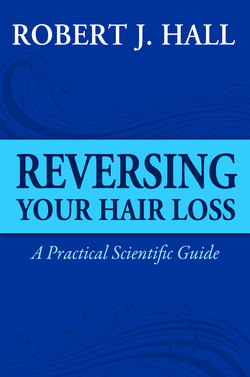Reversing Your Hair Loss - A Practical Scientific Guide

Реклама. ООО «ЛитРес», ИНН: 7719571260.
Оглавление
Robert J. Hall. Reversing Your Hair Loss - A Practical Scientific Guide
Disclaimer
Introduction
Section One. Chapter One. Truth and Lies
Chapter Two. First Impressions
Chapter Three. Skin
Chapter Four. Hair Everywhere
Chapter Five. Hair Types
Chapter Six. Hair Structure
Chapter Seven. Sebum
Chapter Eight. Hair Growth
Section Two. Chapter Nine. Hair-Loss
Chapter Ten. Myths
Chapter Eleven. Patterns
Chapter Twelve. Science
Chapter Thirteen. Evolution
Section Three. Chapter Fourteen. Regrowth
Chapter Fifteen. Diet
Chapter Sixteen. Disguises
Chapter Seventeen. FDA Treatments
Chapter Eighteen. Other Drugs
Chapter Nineteen. Caffeine
Chapter Twenty. Shampoos
Chapter Twenty-One. Polysorbate
Chapter Twenty-Two. Niacin
Chapter Twenty-Three. Superoxide Dismutase
Chapter Twenty-Four. Methylsulphonylmethane
Chapter Twenty-Five. Silica
Chapter Twenty-Six. Serratiopeptidase
Chapter Twenty-Seven. Massage
Chapter Twenty-Eight. Lasers
Chapter Twenty-Nine. Future Treatments
Отрывок из книги
Before reading any more of this book you need to read this part. It is important and it has been placed here for a purpose.
Please read the medical disclaimer at the end of this section. It states that what I write in this book is not medical advice. You should take this disclaimer fairly seriously. Whichever way the material has been worded it has the precise intention of me simply saying what I would do if I were you, or what I have done myself in the past. You should not take anything written here, therefore, as telling you what you should do, ought to do or not do.
.....
The first known animal that definitely had hair was a very early mammalian-type of creature called castorocauda. It looked like a biggish otter and flourished in the middle of the Jurassic Period; this was about the same time as some of the best-known dinosaurs, like the giant swamp-dwelling diplodocus and flying pterodactyls. It was roughly at this point on the evolutionary timeline that feathers also made a first appearance. Both hair and feathers are thought to be genetically derived from the scales of those early dinosaurs.
Human hair actually starts developing in the womb at about fourteen weeks after conception. We do not take much notice of this lanugo hair, as it is called, because it is normally only found on a foetus and thus we never get to see it. Lanugo is replaced by vellus hair at around thirty-four weeks. Babies that still have lanugo are considered to have been born prematurely.
.....